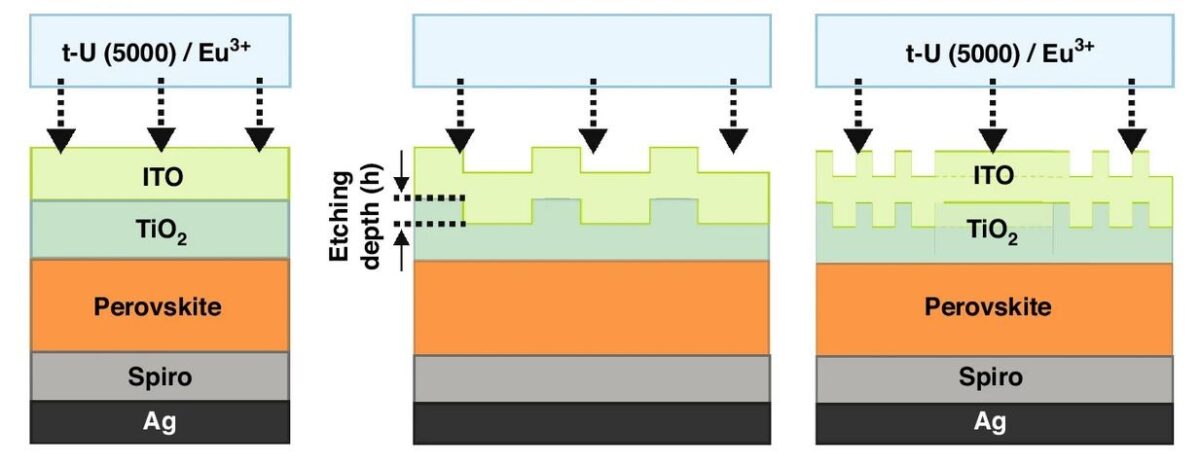Researchers at the Nova University of Lisbon in Portugal have developed an ultrathin perovskite solar cell that utilizes a checkerboard (CB) tile pattern with designated UV photon conversion capability to protect the perovskite layer against UV-enabled degradation and a luminescent down-shifting encapsulant that reportedly improves UV irradiation.
They explained that UV degradation is one of the main factors causing the “irreversible” degradation of perovskites in solar cells, which usually occurs at the interface between the perovskite absorber and the electron transport layer (ETL). “This photostability problem can be easily solved if UV radiation does not reach the interface of ETL/perovskite layers,” they added. “However, by using a UV-shielding encapsulant layer in perovskite solar cells, the UV photon of the solar spectrum will be lost, hence limiting further efficiency gains.”
To proposed combined solution was conceived to solve this issue, as it not only acts as an encapsulant but also as a “photon-recycler” for the incident UV light. The addition of luminescent down-shifting (LDS) fluorophores to the encapsulant enables the conversion of high-energy photons into lower-energy ones. “These lower energy photons can then be absorbed by the perovskite layer without issues, and the increased number of visible photons available for absorption by the cell will in turn increase the external quantum efficiency (EQE) of the cell,” the group stressed.
The team created checkerboard (CB) gratings with symmetry-property to make them suitable for integration as an LT structure into the solar cells and then applied an LDS encapsulant material composed of an experimentally developed tri-ureasil modified by lanthanides onto the CB photonic front structure.
The academics designed the solar cell with a substrate made of indium tin oxide (ITO), a titanium oxide (TiO2) ETL, a perovskite absorber, a hole transport layer (HTL) based on Spiro-OMeTAD, a silver (Ag) metal contact, and the proposed encapsulant with the CB photonic front structure. “The CB grating structures are top-coated as a final processing step, which prevents the structuring of the active absorber layer, which could lead to electrical degradation via increased recombination,” they stated.
With this architecture, they then built two solar cells with perovskite absorbers with a thickness of 250 nm and 500 nm, respectively. Tested under standard illumination conditions, the two devices achieved a 25.9% and 28.2% higher photocurrent, respectively, compared with identical cells with a planar structure and without the new encapsulant and the CB photonic front structure.
“We demonstrate that at least 94% of the impinging UV radiation can be effectively converted into the Visible spectral range,” the research team stated. “Photonic protection from high-energy photons contributes to the market deployment of perovskite solar cell technology, and may become crucial for Space applications under AM0 illumination.”
The new cell concept was explained in the paper “Photon shifting and trapping in perovskite solar cells for improved efficiency and stability,” published in the scientific journal Light.
This content is protected by copyright and may not be reused. If you want to cooperate with us and would like to reuse some of our content, please contact: editors@pv-magazine.com.




By submitting this form you agree to pv magazine using your data for the purposes of publishing your comment.
Your personal data will only be disclosed or otherwise transmitted to third parties for the purposes of spam filtering or if this is necessary for technical maintenance of the website. Any other transfer to third parties will not take place unless this is justified on the basis of applicable data protection regulations or if pv magazine is legally obliged to do so.
You may revoke this consent at any time with effect for the future, in which case your personal data will be deleted immediately. Otherwise, your data will be deleted if pv magazine has processed your request or the purpose of data storage is fulfilled.
Further information on data privacy can be found in our Data Protection Policy.